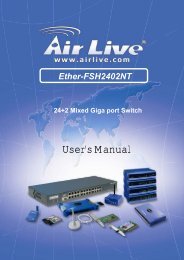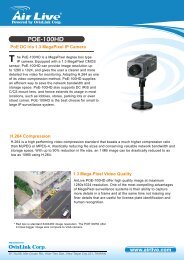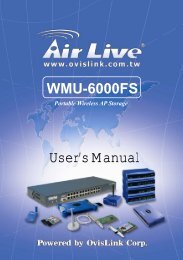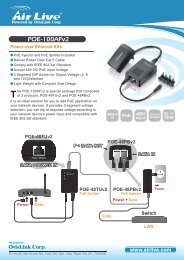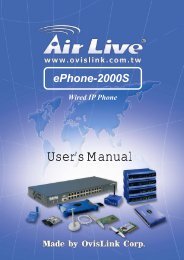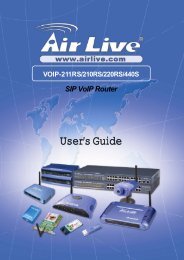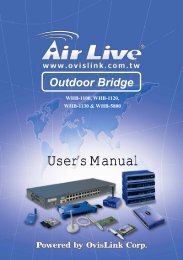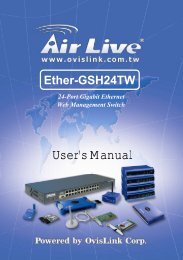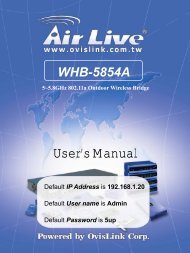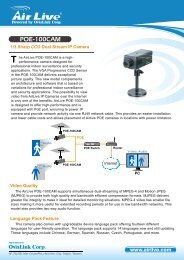IP-1000R - kamery airlive airlivecam
IP-1000R - kamery airlive airlivecam
IP-1000R - kamery airlive airlivecam
- No tags were found...
Create successful ePaper yourself
Turn your PDF publications into a flip-book with our unique Google optimized e-Paper software.
<strong>IP</strong>-<strong>1000R</strong>Wired Broadband RouterUser’s Manual1
CopyrightThe contents of this publication may not be reproduced in any part or as a whole, stored, transcribed inan information retrieval system, translated into any language, or transmitted in any form or by anymeans, mechanical, magnetic, electronic, optical, photocopying, manual, or otherwise, without the priorwritten permission.TrademarksAll products, company, brand names are trademarks or registered trademarks of their respectivecompanies. They are used for identification purpose only. Specifications are subject to be changedwithout prior notice.FCC Interference StatementThe <strong>IP</strong>-<strong>1000R</strong> has been tested and found to comply with the limits for a Class B digital device pursuantto Part 15 of the FCC Rules. These limits are designed to provide reasonable protection against radiointerference in a commercial environment. This equipment can generate, use and radiate radiofrequency energy and, if not installed and used in accordance with the instructions in this manual, maycause harmful interference to radio communications. Operation of this equipment in a residential areais likely to cause interference, in which case the user, at his own expense, will be required to takewhatever measures are necessary to correct the interference.CE Declaration of ConformityThis equipment complies with the requirements relating to electromagnetic compatibility, EN 55022/A1Class B.The specification is subject to change without notice.2
Table of ContentsChapter 1 Introduction ........................................................................................................ 4Functions and Features................................................................................................. 4Packing List ..................................................................................................................... 6Chapter 2 Hardware Installation........................................................................................ 72.1 Panel Layout............................................................................................................. 72.2 Procedure for Hardware Installation ..................................................................... 9Chapter 3 Network Settings and Software Installation ........................................................ 103.1 Make Correct Network Settings of Your Computer........................................... 10Chapter 4 Configuring <strong>IP</strong>-<strong>1000R</strong> Broadband Router........................................................... 114.1 Start-up and Log in ................................................................................................ 124.2 Status ....................................................................................................................... 134.3 Wizard...................................................................................................................... 144.4 Basic Setting........................................................................................................... 154.5 Port Forwarding...................................................................................................... 264.6 Firewall Settings..................................................................................................... 304.7 Advanced Settings ................................................................................................. 434.8 Maintenance ........................................................................................................... 53Appendix A TCP/<strong>IP</strong> Configuration for Windows 95/98...................................................... 58Appendix B FAQ and Troubleshooting ............................................................................... 63Reset to factory Default ............................................................................................... 633
Chaptterr 1 Inttrroductti I ionCongratulations on your purchase of this outstanding <strong>IP</strong>-<strong>1000R</strong>. This product is specifically designedfor Small Office and Home Office needs. It provides a complete SOHO solution for Internet surfing, andis easy to configure and operate even for non-technical users. Instructions for installing and configuringthis product can be found in this manual. Before you install and use this product, please read thismanual carefully for fully exploiting the functions of this product.Functions and FeaturesRouter Basic functions• Auto-sensing Ethernet SwitchEquipped with a 4-port auto-sensing Ethernet switch.• WAN type supportedThe router supports some WAN types, Static, Dynamic, PPPoE , PPTP ,L2TP, Dynamic <strong>IP</strong>with Road Runner.• FirewallAll unwanted packets from outside intruders are blocked to protect your Intranet.• DHCP server supportedAll of the networked computers can retrieve TCP/<strong>IP</strong> settings automatically from this product.• Web-based configuringConfigurable through any networked computer’s web browser using Netscape or InternetExplorer.• Virtual Server supportedEnable you to expose WWW, FTP and other services on your LAN to be accessible to Internetusers.• User-Definable Application Sensing TunnelUser can define the attributes to support the special applications requiring multipleconnections, like Internet gaming, video conferencing, Internet telephony and so on, then thisproduct can sense the application type and open multi-port tunnel for it.• DMZ Host supportedLets a networked computer be fully exposed to the Internet; this function is used when specialapplication sensing tunnel feature is insufficient to allow an application to function correctly.• Statistics of WAN SupportedEnables you to monitor inbound and outbound packets4
Wireless functions• High speed for wireless LAN connectionUp to 54Mbps data rate by incorporating Orthogonal Frequency Division Multiplexing(OFDM).• RoamingProvides seamless roaming within the IEEE 802.11b (11M) and IEEE 802.11g (54M) WLANinfrastructure.• IEEE 802.11b compatible (11M)Allowing inter-operation among multiple vendors.• IEEE 802.11g compatible (54M)Allowing inter-operation among multiple vendors.• Auto fallback54M, 48M, 36M, 24M, 18M, 12M, 6M data rate with auto fallback in 802.11g mode.11M, 5.5M, 2M, 1M data rate with auto fallback in 802.11b mode.Security functions• Packet filter supportedPacket Filter allows you to control access to a network by analyzing the incoming andoutgoing packets and letting them pass or halting them based on the <strong>IP</strong> address of the sourceand destination.• Domain Filter SupportedLet you prevent users under this device from accessing specific URLs.• URL Blocking SupportedURL Blocking can block hundreds of websites connection by simply a keyword.• VPN Pass-throughThe router also supports VPN pass-through.• 802.1X supportedWhen the 802.1X function is enabled, the Wireless user must authenticate to this router firstto use the Network service.• Support WPA-PSK and WPAWhen the WPA function is enabled, the Wireless user must authenticate to this router first touse the Network service• SPI Mode SupportedWhen SPI Mode is enabled, the router will check every incoming packet to detect if thispacket is valid.• DoS Attack Detection Supported5
When this feature is enabled, the router will detect and log the DoS attack comes from theInternet.Advanced functions• System time SupportedAllow you to synchronize system time with network time server.• E-mail Alert SupportedThe router can send its info by mail.• Dynamic dns SupportedAt present,the router has 3 ddns.dyndns,TZO.com and dhs.org.• SNMP SupportedThe router supports basic SNMP function.• Routing Table SupportedNow, the router supports static routing.• Schedule Rule supportedCustomers can control some functions, like virtual server and packet filters when to access orwhen to block.Other functions• UPNP (Universal Plug and Play)SupportedThe router also supports this function. The applications: X-box, Msn Messenger.Packing List• Wireless broadband router unit• Installation CD-ROM• Power adapter• CAT-5 UTP Fast Ethernet cable6
Chaptterr 2 Harrdwarre IInsttal llattiion2.1 Panel Layout2.1.1. Front PanelFigure 2-1 Front PanelLED:LED Function Color Status DescriptionPOWERPowerindicationGreen On Power is being applied to this product.StatusSystemstatusGreenBlinkingStatus is flashed once per second to indicate systemis alive.WANWAN portactivityGreenOnBlinkingThe WAN port is linked.The WAN port is sending or receiving data.W.LANWirelessactivityGreen Blinking Sending or receiving data via wirelessLink/Act.1~4Link statusGreenOnBlinkingAn active station is connected to the correspondingLAN port.The corresponding LAN port is sending or receivingdata.10/100 Data Rate Green OnData is transmitting in 100Mbps on thecorresponding LAN port.7
2.1.2. Rear PanelFigure 2-2 Rear PanelPorts:PortPWRWANPort 1 - 4RESETDescriptionPower inletThe port where you will connect your cable (or DSL) modem or Ethernet router.The ports where you will connect networked computers and other devices.To reset system settings to factory defaults8
2.2 Procedure for Hardware Installation2. Decide where to place your <strong>IP</strong>-<strong>1000R</strong> Wireless Broadband RouterYou can place your <strong>IP</strong>-<strong>1000R</strong> Wireless Broadband Router on a desk or other flat surface, or youcan mount it on a wall. For optimal performance, place your <strong>IP</strong>-<strong>1000R</strong> Wireless Broadband Routerin the center of your office (or your home) in a location that is away from any potential source ofinterference, such as a metal wall or microwave oven. This location must be close to power andnetwork connection.2. Setup LAN connectiona. Wired LAN connection: connects an Ethernet cable from your computer’s Ethernet port to one ofthe LAN ports of this product.b. Wireless LAN connection: locate this product at a proper position to gain the best transmitperformanceFigure 2-3 Setup of LAN and WAN connections for this product.3. Setup WAN connectionPrepare an Ethernet cable for connecting this product to your cable/xDSL modem or Ethernetbackbone. Figure 2-3 illustrates the WAN connection.4. Power onConnecting the power cord to power inlet and turning the power switch on, this product willautomatically enter the self-test phase. When it is in the self-test phase, the indicators M1 will belighted ON for about 10 seconds, and then M1 will be flashed 3 times to indicate that the self-testoperation has finished. Finally, the M1 will be continuously flashed once per second to indicate thatthis product is in normal operation.9
Chaptterr 3 Nettworrk Setttti ings and Soffttwarre Insttal I llattiionTo use this product correctly, you have to properly configure the network settings of your computers andinstall the attached setup program into your MS Windows platform (Windows 95/98/NT/2000).3.1 Make Correct Network Settings of Your ComputerThe default <strong>IP</strong> address of this product is 192.168.1.254, and the default subnet mask is 255.255.255.0.These addresses can be changed on your need, but the default values are used in this manual. If theTCP/<strong>IP</strong> environment of your computer has not yet been configured, you can refer to Appendix A toconfigure it. For example,1. configure <strong>IP</strong> as 192.168.1.1, subnet mask as 255.255.255.0 and gateway as 192.168.1.254, ormore easier,2. configure your computers to load TCP/<strong>IP</strong> setting automatically, that is, via DHCP server of thisproduct.After installing the TCP/<strong>IP</strong> communication protocol, you can use the ping command to check if yourcomputer has successfully connected to this product. The following example shows the ping procedurefor Windows 95 platforms. First, execute the ping commandping 192.168.1.254If the following messages appear:Pinging 192.168.1.254 with 32 bytes of data:Reply from 192.168.1.254: bytes=32 time=2ms TTL=64a communication link between your computer and this product has been successfully established.Otherwise, if you get the following messages,Pinging 192.168.1.254 with 32 bytes of data:Request timed out.There must be something wrong in your installation procedure. You have to check the following items insequence:1. Is the Ethernet cable correctly connected between this product and your computer?Tip: The LAN LED of this product and the link LED of network card on your computer must belighted.2. Is the TCP/<strong>IP</strong> environment of your computers properly configured?Tip: If the <strong>IP</strong> address of this product is 192.168.1.254, the <strong>IP</strong> address of your computer must be192.168.1.X and default gateway must be 192.168.1.254.10
Chaptterr 4 Conffi igurri ing <strong>IP</strong>--<strong>1000R</strong> I Brroadband RoutterrThis product provides Web based configuration scheme, that is, configuring by your Web browser, suchas Netscape Communicator or Internet Explorer. This approach can be adopted in any MS Windows,Macintosh or UNIX based platforms.11
4.1 Start-up and Log inActivate your browser, and disable the proxy or add the <strong>IP</strong> address of this product into theexceptions. Then, type this product’s <strong>IP</strong> address in the Location (for Netscape) or Address (for IE) fieldand press ENTER. For example: http://192.168.1.254.After the connection is established, you will see the web user interface of this product. There are twoappearances of web user interface: for general users and for system administrator.A window would pop-up asking for Login and Password. Please enter “admin” for login, and “<strong>airlive</strong>”or “ovislink” for password12
4.2 StatusThis option provides the function for observing this product’s working status:A. WAN Port Status.If the WAN port is assigned a dynamic <strong>IP</strong>, there may appear a “Renew” or “Release” buttonon the Sidenote column. You can click this button to renew or release <strong>IP</strong> manually.B. Statistics of WAN: enables you to monitor inbound and outbound packets13
4.3 WizardSetup Wizard will guide you through a basic configuration procedure step by step. Press”Next ”Setup Wizard - Select WAN Type: For detail settings, please refer to 4.4.1 primary setup.14
4.4 Basic Setting4.4.1 Primary Setup – WAN Type, Virtual ComputersPress “Change”15
This option is primary to enable this product to work properly. The setting items and the webappearance depend on the WAN type. Choose correct WAN type before you start.1. LAN <strong>IP</strong> Address: the local <strong>IP</strong> address of this device. The computers on your network must use theLAN <strong>IP</strong> address of your product as their Default Gateway. You can change it if necessary.2. WAN Type: WAN connection type of your ISP. You can click Change button to choose a correctone from the following four options:A. Static <strong>IP</strong> Address: ISP assigns you a static <strong>IP</strong> address.B. Dynamic <strong>IP</strong> Address: Obtain an <strong>IP</strong> address from ISP automatically.C. Dynamic <strong>IP</strong> Address with Road Runner Session Management.(e.g. Telstra BigPond)D. PPP over Ethernet: Some ISPs require the use of PPPoE to connect to their services.E. PPTP: Some ISPs require the use of PPTP to connect to their services.F. L2TP: Some ISPs require the use of L2TP to connect to their services16
4.4.1.1 Static <strong>IP</strong> AddressWAN <strong>IP</strong> Address, Subnet Mask, Gateway, Primary and Secondary DNS: enter the proper settingprovided by your ISP.4.4.1.2 Dynamic <strong>IP</strong> Address1. Host Name: optional. Required by some ISPs, for example, @Home.2. Renew <strong>IP</strong> Forever: this feature enables this product to renew your <strong>IP</strong> address automatically whenthe lease time is expiring-- even when the system is idle.4.4.1.3 Dynamic <strong>IP</strong> Address with Road Runner Session Management.(e.g. Telstra BigPond)1. LAN <strong>IP</strong> Address is the <strong>IP</strong> address of this product. It must be the default gateway of yourcomputers.2. WAN Type is Dynamic <strong>IP</strong> Address. If the WAN type is not correct, change it!3. Host Name: optional. Required by some ISPs, e.g. @Home.4. Renew <strong>IP</strong> Forever: this feature enable this product renew <strong>IP</strong> address automatically when thelease time is being expired even the system is in idle state.4.4.1.4 PPP over Ethernet1. PPPoE Account and Password: the account and password your ISP assigned to you. Forsecurity,this field appears blank. If you don't want to change the password, leave it empty.2. PPPoE Service Name: optional. Input the service name if your ISP requires it. Otherwise, leaveit blank.3. Maximum Idle Time: the amount of time of inactivity before disconnecting your PPPoE session.Set it to zero or enable Auto-reconnect to disable this feature.4. Maximum Transmission Unit (MTU): Most ISP offers MTU value to users. The most commonMTU value is 1492.5. Connection Control: There are 3 modes to select:Connect-on-demand: The device will link up with ISP when the clients send outgoing packets.Auto-Reconnect(Always-on): The device will link up with ISP until the connection is established.Manually: The device will not make the link until someone clicks the connect-button in theStatus-page.17
4.4.1.5 PPTP1. My <strong>IP</strong> Address and My Subnet Mask: the private <strong>IP</strong> address and subnet mask your ISP assignedto you.2. Server <strong>IP</strong> Address: the <strong>IP</strong> address of the PPTP server.3. PPTP Account and Password: the account and password your ISP assigned to you. If you don'twant to change the password, keep it empty.3. Connection ID: optional. Input the connection ID if your ISP requires it.4. Maximum Idle Time: the time of no activity to disconnect your PPTP session. Set it to zero orenable Auto-reconnect to disable this feature. If Auto-reconnect is enabled, this product willconnect to ISP automatically, after system is restarted or connection is dropped.5. Connection Control: There are 3 modes to select:Connect-on-demand: The device will link up with ISP when the clients send outgoing packets.Auto-Reconnect(Always-on):The device will link upw with ISP until the connection is established.Manually: The device will not make the link until someone clicks the connect-button in theStatus-page.18
4.4.1.6 L2TPFirst, please check your ISP assigned and Select Static <strong>IP</strong> Address or Dynamic <strong>IP</strong> Address.For example: Use Static1. My <strong>IP</strong> Address and My Subnet Mask: the private <strong>IP</strong> address and subnet mask your ISP assignedto you.2. Server <strong>IP</strong> Address: the <strong>IP</strong> address of the PPTP server.3. PPTP Account and Password: the account and password your ISP assigned to you. If you don’twant to change the password, keep it empty.3. Connection ID: optional. Input the connection ID if your ISP requires it.4. Maximum Idle Time: the time of no activity to disconnect your PPTP session. Set it to zero orenable Auto-reconnect to disable this feature. If Auto-reconnect is enabled, this product willconnect to ISP automatically, after system is restarted or connection is dropped.6. Connection Control: There are 3 modes to select:Connect-on-demand: The device will link up with ISP when the clients send outgoing packets.Auto-Reconnect(Always-on):The device will link up with ISP until the connection is established.Manually: The device will not make the link until someone clicks the connect-button in theStatus-page.19
4.4.1.7 Virtual ComputersVirtual Computer enables you to use the original NAT feature, and allows you to setup the one-to-onemapping of multiple global <strong>IP</strong> address and local <strong>IP</strong> address.• Global <strong>IP</strong>: Enter the global <strong>IP</strong> address assigned by your ISP.• Local <strong>IP</strong>: Enter the local <strong>IP</strong> address of your LAN PC corresponding to the global <strong>IP</strong> address.• Enable: Check this item to enable the Virtual Computer feature.20
4.4.2 DHCP ServerPress “More”The settings of a TCP/<strong>IP</strong> environment include host <strong>IP</strong>, Subnet Mask, Gateway, and DNS configurations.It is not easy to manually configure all the computers and devices in your network. Fortunately, DHCPServer provides a rather simple approach to handle all these settings. This product supports thefunction of DHCP server. If you enable this product’s DHCP server and configure your computers as“automatic <strong>IP</strong> allocation” mode, then when your computer is powered on, it will automatically load theproper TCP/<strong>IP</strong> settings from this product. The settings of DHCP server include the following items:1. DHCP Server: Choose “Disable” or “Enable.”2. <strong>IP</strong> pool starting Address/ <strong>IP</strong> pool starting Address: Whenever there is a request, the DHCPserver will automatically allocate an unused <strong>IP</strong> address from the <strong>IP</strong> address pool to therequesting computer. You must specify the starting and ending address of the <strong>IP</strong> address pool.3. Domain Name: Optional, this information will be passed to the client.4. Primary DNS/Secondary DNS: This feature allows you to assign DNS Servers5. Primary WINS/Secondary WINS: This feature allows you to assign WINS Servers6. Gateway: The Gateway Address would be the <strong>IP</strong> address of an alternate Gateway.This function enables you to assign another gateway to your PC, when DHCPserver offers an <strong>IP</strong> to your PC.21
4.4.3 Wireless Setting, and 802.1X settingWireless settings allow you to set the wireless configuration items.1. Network ID (SSID): Network ID is used for identifying the Wireless LAN (WLAN). Client stationscan roam freely over this product and other Access Points that have the same Network ID. (Thefactory setting is “default”)2. Channel: The radio channel number. The permissible channels depend on the Regulatory Domain.The factory setting is as follow: channel 6 for North America; channel 7 for European (ETSI);channel 7 for Japan.3. WEP Security: Select the data privacy algorithm you want. Enabling the security can protect yourdata while it is transferred from one station to another. The standardized IEEE 802.11 WEP (128 or64-bit) is used here.4. WEP Key 1, 2, 3 & 4: When you enable the 128 or 64 bit WEP key security, please select one WEPkey to be used and input 26 or 10 hexadecimal (0, 1, 2…8, 9, A, B…F) digits.5. Pass-phrase Generator: Since hexadecimal characters are not easilyremembered, this device offers a conversion utility to convert a simpleword or phrase into hex.6. 802.1X Setting22
802.1XCheck Box was used to switch the function of the 802.1X. When the 802.1X function is enabled, theWireless user must authenticate to this router first to use the Network service.RADIUS Server<strong>IP</strong> address or the 802.1X server’s domain-name.RADIUS Shared KeyKey value shared by the RADIUS server and this router. This key value is consistent with the key valuein the RADIUS server.23
WPA-PSK1. Select Preshare Key ModeIf you select HEX,you have to fill in 64 hexadecimal (0, 1, 2…8, 9, A, B…F) digitsIf ASCII,the length of preshare key is from 8 to 63.2. Fill in the key, Ex 1234567824
WPACheck Box was used to switch the function of the WPA. When the WPA function is enabled, theWireless user must authenticate to this router first to use the Network service. RADIUS Server<strong>IP</strong> address or the 802.1X server’s domain-name.RADIUS Shared KeyKey value shared by the RADIUS server and this router. This key value is consistent with the key valuein the RADIUS server.25
4.5 Port Forwarding4.5.1 Virtual ServerThis product’s NAT firewall filters out unrecognized packets to protect your Intranet, so all hosts behindthis product are invisible to the outside world. If you wish, you can make some of them accessible byenabling the Virtual Server Mapping.A virtual server is defined as a Service Port, and all requests to this port will be redirected to thecomputer specified by the Server <strong>IP</strong>. Virtual Server can work with Scheduling Rules, and give usermore flexibility on Access control. For Detail, please refer to Scheduling Rule.For example, if you have an FTP server (port 21) at 192.168.1.1, a Web server (port 80) at 192.168.1.2,and a VPN server at 192.168.1.6, then you need to specify the following virtual server mapping table:26
Service Port Server <strong>IP</strong> Enable21 192.168.1.1 V80 192.168.1.2 V1723 192.168.1.6 V27
4.5.2 Special APSome applications require multiple connections, like Internet games, Video conferencing, Internettelephony, etc. Because of the firewall function, these applications cannot work with a pure NAT router.The Special Applications feature allows some of these applications to work with this product. If themechanism of Special Applications fails to make an application work, try setting your computer as theDMZ host instead.1. Trigger: the outbound port number issued by the application..2. Incoming Ports: when the trigger packet is detected, the inbound packets sent to the specifiedport numbers are allowed to pass through the firewall.This product provides some predefined settings Select your application and click Copy to to add thepredefined setting to your list.Note! At any given time, only one PC can use each Special Application tunnel.4.5.3 Miscellaneous Items28
<strong>IP</strong> Address of DMZ HostDMZ (DeMilitarized Zone) Host is a host without the protection of firewall. It allows a computer to beexposed to unrestricted 2-way communication for Internet games, Video conferencing, Internettelephony and other special applications.NOTE: This feature should be used only when needed.Non-standard FTP portYou have to configure this item if you want to access an FTP server whose port number is not 21. Thissetting will be lost after rebooting.29
4.6 Firewall Settings30
4.6.1 Packet FilterPacket Filter enables you to control what packets are allowed to pass the router. Outbound filter applieson all outbound packets. However, Inbound filter applies on packets that destined to Virtual Servers orDMZ host only. You can select one of the two filtering policies:1. Allow all to pass except those match the specified rules2. Deny all to pass except those match the specified rulesYou can specify 8 rules for each direction: inbound or outbound. For each rule, you can define thefollowing:• Source <strong>IP</strong> address• Source port address• Destination <strong>IP</strong> address• Destination port address• Protocol: TCP or UDP or both.• Use Rule#For source or destination <strong>IP</strong> address, you can define a single <strong>IP</strong> address (4.3.2.1) or a range of <strong>IP</strong>addresses (4.3.2.1-4.3.2.254). An empty implies all <strong>IP</strong> addresses.31
For source or destination port, you can define a single port (80) or a range of ports (1000-1999). Addprefix "T" or "U" to specify TCP or UDP protocol. For example, T80, U53, U2000-2999. No prefixindicates both TCP and UDP are defined. An empty implies all port addresses. Packet Filter can workwith Scheduling Rules, and give user more flexibility on Access control. For Detail, please refer toScheduling Rule.Each rule can be enabled or disabled individually.Inbound Filter:To enable Inbound Packet Filter click the check box next to Enable in the Inbound Packet Filterfield.Suppose you have SMTP Server (25), POP Server (110), Web Server (80), FTP Server (21), and NewsServer (119) defined in Virtual Server or DMZ Host.Example 1:(1.2.3.100-1.2.3.149) They are allow to send mail (port 25), receive mail (port 110), and browse theInternet (port 80)(1.2.3.10-1.2.3.20) They can do everything (block nothing) Others are all blocked.32
Example 2:(1.2.3.100-1.2.3.119) They can do everything except read net news (port 119) and transfer files via FTP(port 21)Others are all allowed.After Inbound Packet Filter setting is configured, click the save button.Outbound Filter:To enable Outbound Packet Filter click the check box next to Enable in the Outbound Packet Filterfield.33
Example 1:(192.168.1.100-192.168.1.149) They are allowed to send mail (port 25), receive mail (port 110), andbrowse Internet (port 80); port 53 (DNS) is necessary to resolve the domain name.(192.168.1.10-192.168.1.20) They can do everything (block nothing)Others are all blocked.34
Example 2:(192.168.1.100-192.168.1.119) They can do everything except read net news (port 119) and transferfiles via FTP (port 21)Others are allowedAfter Outbound Packet Filter setting is configured, click the save button.35
4.6.2 Domain FilterDomain FilterLet you prevent users under this device from accessing specific URLs.Domain Filter EnableCheck if you want to enable Domain Filter.Log DNS QueryCheck if you want to log the action when someone accesses the specific URLs.Privilege <strong>IP</strong> Addresses RangeSetting a group of hosts and privilege these hosts to access network without restriction.Domain SuffixA suffix of URL to be restricted. For example, ".com", "xxx.com".ActionWhen someone is accessing the URL met the domain-suffix, what kind of action you want.Check drop to block the access. Check log to log these access.EnableCheck to enable each rule.36
Example:In this example:1. URL include “www.msn.com” will be blocked, and the action will be record in log-file.2. URL include “www.sina.com” will not be blocked, but the action will be record in log-file.3. URL include “www.google.com” will be blocked, but the action will not be record in log-file.4. <strong>IP</strong> address X.X.X.1~ X.X.X.20 can access network without restriction.37
4.6.3 URL BlockingURL Blocking will block LAN computers to connect to pre-defined Websites.The major difference between “Domain filter” and “URL Blocking” is Domain filter require user to inputsuffix (like .com or .org, etc), while URL Blocking require user to input a keyword only. In other words,Domain filter can block specific website, while URL Blocking can block hundreds of websites by simplya keyword.URL Blocking EnableChecked if you want to enable URL Blocking.URLIf any part of the Website's URL matches the pre-defined word, the connection will be blocked.For example, you can use pre-defined word "sex" to block all websites if their URLs contain pre-definedword "sex".EnableChecked it to enable each rule.38
In this example:1. URL include “msn” will be blocked, and the action will be record in log-file.2. URL include “sina” will be blocked, but the action will be record in log-file3. URL include “cnnsi” will not be blocked, but the action will be record in log-file.4. URL include “espn” will be blocked, but the action will be record in log-file39
4.6.4 MAC Address ControlMAC Address Control allows you to assign different access right for different users and to assign aspecific <strong>IP</strong> address to a certain MAC address.MAC Address ControlCheck “Enable” to enable the “MAC Address Control”. All of thesettings in this page will take effect only when “Enable” is checked.Connection control Check "Connection control" to enable the controlling of which wired andwireless clients can connect to this device. If a client is denied to connect tothis device, it means the client can't access to the Internet either. Choose"allow" or "deny" to allow or deny the clients, whose MAC addresses are notin the "Control table" (please see below), to connect to this device.Association controlCheck "Association control" to enable the controlling of which wirelessclient can associate to the wireless LAN. If a client is denied to associateto the wireless LAN, it means the client can't send or receive any data viathis device. Choose "allow" or "deny" to allow or deny the clients, whoseMAC addresses are not in the "Control table", to associate to the wirelessLAN.40
Control table"Control table" is the table at the bottom of the "MAC Address Control" page.Each row of this table indicates the MAC address and the expected <strong>IP</strong>address mapping of a client. There are four columns in this table:MAC Address<strong>IP</strong> AddressCAMAC address indicates a specific client.Expected <strong>IP</strong> address of the correspondingclient. Keep it empty if you don't care its <strong>IP</strong>address.When "Connection control" is checked,check "C" will allow the correspondingclient to connect to this device.When "Association control" is checked,check "A" will allow the correspondingclient to associate to the wireless LAN.In this page, we provide the following Combobox and button to help you to input the MAC address.You can select a specific client in the “DHCP clients” Combobox, and then click on the “Copy to” buttonto copy the MAC address of the client you select to the ID selected in the “ID” Combobox.Previous page and Next Page To make this setup page simple and clear, we have divided the“Control table” into several pages. You can use these buttons tonavigate to different pages.41
4.6.5 Miscellaneous ItemsRemote Administrator Host/PortIn general, only Intranet user can browse the built-in web pages to perform administration task. Thisfeature enables you to perform administration task from remote host. If this feature is enabled, only thespecified <strong>IP</strong> address can perform remote administration. If the specified <strong>IP</strong> address is 0.0.0.0, any hostcan connect to this product to perform administration task. You can use subnet mask bits "/nn" notationto specified a group of trusted <strong>IP</strong> addresses. For example, "10.1.2.0/24".NOTE: When Remote Administration is enabled, the web server port will be shifted to 88. You canchange web server port to other port, too.Administrator Time-outThe time of no activity to logout automatically. Set it to zero to disable this feature.Discard PING from WAN sideWhen this feature is enabled, any host on the WAN cannot ping this product.SPI ModeWhen this feature is enabled, the router will record the packet information pass through the router like<strong>IP</strong> address, port address, ACK, SEQ number and so on. And the router will check every incomingpacket to detect if this packet is valid.DoS Attack DetectionWhen this feature is enabled, the router will detect and log the DoS attack comes from the Internet.Currently, the router can detect the following DoS attack: SYN Attack, WinNuke, Port Scan, Ping ofDeath, Land Attack etc.42
4.7 Advanced Settings4.7.1 System Time43
Get Date and Time by NTP ProtocolSelected if you want to Get Date and Time by NTP Protocol.Time ServerSelect a NTP time server to consult UTC timeTime ZoneSelect a time zone where this device locates.Set Date and Time manuallySelected if you want to Set Date and Time manually.Set Date and Time manuallySelected if you want to Set Date and Time manually.Function of ButtonsSync Now: Synchronize system time with network time serverDaylight Saving:Set up where the location is.4.7.2 System LogThis page support two methods to export system logs to specific destination by means of syslog(UDP)and SMTP(TCP). The items you have to setup including:44
<strong>IP</strong> Address for SyslogHost <strong>IP</strong> of destination where syslogs will be sent to.Check Enable to enable this function.E-mail Alert EnableCheck if you want to enable Email alert (send syslog via email).SMTP Server <strong>IP</strong> and PortInput the SMTP server <strong>IP</strong> and port, which are connected with ':'. If you do not specify port number, thedefault value is 25.For example, "mail.your_url.com" or "192.168.1.100:26".Send E-mail alert toThe recipients who will receive these logs. You can assign more than 1 recipient, using ';' or ',' toseparate these email addresses.4.7.3 Dynamic DNSTo host your server on a changing <strong>IP</strong> address, you have to use dynamic domain name service (DDNS).So that anyone wishing to reach your host only needs to know the name of it. Dynamic DNS will mapthe name of your host to your current <strong>IP</strong> address, which changes each time you connect your Internetservice provider.Before you enable Dynamic DNS, you need to register an account on one of these Dynamic DNSservers that we list in provider field.To enable Dynamic DNS click the check box next to Enable in the DDNS field.45
Next you can enter the appropriate information about your Dynamic DNS Server.You have to define:ProviderHost NameUsername/E-mailPassword/KeyYou will get this information when you register an account on a Dynamic DNS server.Example:After Dynamic DNS setting is configured, click the save button.46
4.7.4 SNMP SettingIn brief, SNMP, the Simple Network Management Protocol, is a protocol designed to give a user thecapability to remotely manage a computer network by polling and setting terminal values andmonitoring network events.Enable SNMPYou must check either Local or Remote or both to enable SNMP function. If Local is checked, thisdevice will response request from LAN. If Remote is checked, this device will response request fromWAN.Get CommunitySetting the community of GetRequest your device will response.Set CommunitySetting the community of SetRequest your device will accept.47
Example:Configuration on NAT RouterDestination SubnetMask Gateway Hop Enabled192.168.1.0 255.255.255.0 192.168.123.216 1 ˇ192.168.0.0 255.255.255.0 192.168.123.103 1 ˇSo if, for example, the client3 wanted to send an <strong>IP</strong> data gram to 192.168.0.2, it would use the abovetable to determine that it had to go via 192.168.1.103 (a gateway),And if it sends Packets to 192.168.1.11 will go via 192.168.1.216Each rule can be enabled or disabled individually.After routing table setting is configured, click the save button.49
4.7.6 Schedule RuleYou can set the schedule time to decide which service will be turned on or off. Select the “enable” item.Press “Add New Rule”You can write a rule name and set which day and what time to schedule from “Start Time” to “End Time”.The following example configure “ftp time” as everyday 14:10 to 16:2050
After configure Rule 1Schedule EnableSelected if you want to Enable the Scheduler.EditTo edit the schedule rule.DeleteTo delete the schedule rule, and the rule# of the rules behind the deleted one will decrease oneautomatically.Schedule Rule can be apply to Virtual server and Packet Filter, for example:51
Exanple1: Virtual Server – Apply Rule#1 (ftp time: everyday 14:10 to 16:20)Exanple2: Packet Filter – Apply Rule#1 (ftp time: everyday 14:10 to 16:20).52
4.8 Maintenance53
4.8.1 Change PasswordYou can change Password here. We strongly recommend you to change the system password forsecurity reason.4.8.2 System LogYou can View system log by clicking the View Log button54
4.8.2 Firmware UpgradeYou can upgrade firmware by clicking Firmware Upgrade button.55
4.8.3 Backup SettingYou can backup your settings by clicking the Backup Setting button and save it as a bin file. Once youwant to restore these settings, please click Firmware Upgrade button and use the bin file you saved.4.8.4 Reset to defaultYou can also reset this product to factory default by clicking the Reset to default button.4.8.5 RebootYou can also reboot this product by clicking the Reboot button.56
4.8.6 Miscellaneous ItemsMAC Address for Wake-on-LANWake-on-LAN is a technology that enables you to power up a networked device remotely. In order toenjoy this feature, the target device must be Wake-on-LAN enabled and you have to know the MACaddress of this device, say 00-11-22-33-44-55. Clicking "Wake up" button will make the router to sendthe wake-up frame to the target device immediately.57
Appendiix A TCP/ /<strong>IP</strong> Conffi igurratti ion fforr Windows 95/ /98This section introduces you how to install TCP/<strong>IP</strong> protocol into your personal computer. And supposeyou have been successfully installed one network card on your personal computer. If not, please referto your network card manual. Moreover, the Section B.2 tells you how to set TCP/<strong>IP</strong> values for workingwith this NAT Router correctly.A.1 Install TCP/<strong>IP</strong> Protocol into Your PC1. Click Start button and choose Settings, then click Control Panel.2. Double click Network icon and select Configuration tab in the Network window.3. Click Add button to add network component into your PC.4. Double click Protocol to add TCP/<strong>IP</strong> protocol.5. Select Microsoft item in the manufactures list. And choose TCP/<strong>IP</strong> in the Network Protocols. ClickOK button to return to Network window.58
6. The TCP/<strong>IP</strong> protocol shall be listed in the Network window. Click OK to complete the installprocedure and restart your PC to enable the TCP/<strong>IP</strong> protocol.A.2 Set TCP/<strong>IP</strong> Protocol for Working with NAT Router1. Click Start button and choose Settings, then click Control Panel.2. Double click Network icon. Select the TCP/<strong>IP</strong> line that has been associated to your network card inthe Configuration tab of the Network window.3. Click Properties button to set the TCP/<strong>IP</strong> protocol for this NAT Router.4. Now, you have two setting methods:59
a. Select Obtain an <strong>IP</strong> address automatically in the <strong>IP</strong> Address tab.b. Don’t input any value in the Gateway tab.60
c. Choose Disable DNS in the DNS Configuration tab.B. Configure <strong>IP</strong> manuallya. Select Specify an <strong>IP</strong> address in the <strong>IP</strong> Address tab. The default <strong>IP</strong> address of thisproduct is 192.168.1.254. So please use 192.168.1.xxx (xxx is between 1 and 253) for<strong>IP</strong> Address field and 255.255.255.0 for Subnet Mask field.61
. In the Gateway tab, add the <strong>IP</strong> address of this product (default <strong>IP</strong> is 192.168.1.254) inthe New gateway field and click Add button.c. In the DNS Configuration tab, add the DNS values which are provided by the ISP intoDNS Server Search Order field and click Add button.62
Appendix BFAQ and Trroubl leshootti ingReset to factory DefaultThere are 2 methods to reset to default.1. Restore with RESET buttonFirst, turn off the router and press the RESET button in. And then, power on the router and push the RESET buttondown until the M1 and or M2 LED (or Status LED) start flashing, then remove the finger. If LED flashes about 8times, the RESTORE process is completed. However, if LED flashes 2 times, repeat.2. Restore directly when the router power onFirst, push the RESET button about 5 seconds (M1 will start flashing about 5 times), remove the finger. The RESTORE process is completed.63



